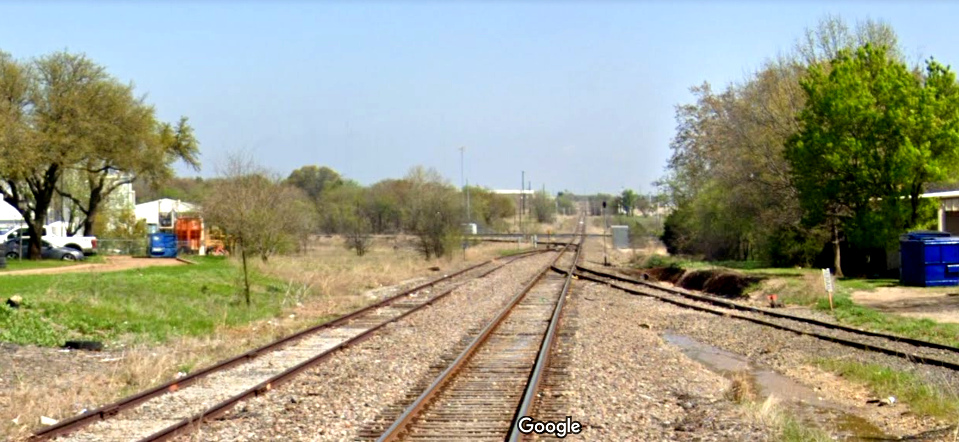

Above Left: ATSF 3136 rolls by Tower 94 in October 1976. (Gary Morris photo) Above Right: Tower 94 photographed on May 16, 1981 (Myron Malone photo)


Above Left: ATSF 3136 rolls by Tower 94 in October
1976. (Gary Morris photo) Above Right:
Tower 94 photographed on May 16, 1981 (Myron Malone photo)
 The
settlement at Midlothian dates back to the 1870s when it was first known
as Barker. The Handbook of Texas states... "The name was changed to
Midlothian in 1882 or 1883. Most accounts agree that the name was suggested by a
Scottish train engineer after a location in his home country." Use of
the Midlothian name dates back to at least December, 1881. (Left:
Dallas Daily Herald, December 13,
1881)
The
settlement at Midlothian dates back to the 1870s when it was first known
as Barker. The Handbook of Texas states... "The name was changed to
Midlothian in 1882 or 1883. Most accounts agree that the name was suggested by a
Scottish train engineer after a location in his home country." Use of
the Midlothian name dates back to at least December, 1881. (Left:
Dallas Daily Herald, December 13,
1881)
If a Scottish train engineer actually suggested the community of Barker be
renamed Midlothian, it was probably in the summer of 1881 and there's a good chance he did so
while piloting a work train of the Chicago, Texas & Mexican Central (CT&MC)
Railway. There was definitely some Scottish money behind
the CT&MC; perhaps the Scottish financiers sent their own
railroad expert to monitor their investment. To collect a bonus, the CT&MC was attempting to finish its 53-mile line
between Dallas and Cleburne before the end of 1881,
and Midlothian was roughly the halfway point.
The first effort to build
between Dallas and Cleburne was chartered November 23, 1876 as the Dallas & Cleburne Railroad Co., proposed as a
narrow gauge line between those cities, but neither local nor foreign capital could be raised. Three years later, on July 11, 1879, new investors
changed the Dallas & Cleburne name to add "Rio Grande"
and began surveying a right-of-way (ROW) for the DC&RG. During the survey, the plan was
changed to adopt standard gauge; the prior narrow gauge approach was viewed as
inadequate for the expected commerce and connections. As the calendar turned to
1880, the DC&RG had yet to move any dirt at all, and its management was focused on joining forces
with the newly formed Texas Trunk Railroad, which had been chartered to build
southeast from Dallas to Sabine Pass. A story in the
Dallas Daily Herald of May 8, 1880, reported an agreement between the two
railroads and announced... "Hereafter, we are informed, there is to be an
identity of interests and management of the Texas Trunk and the Dallas, Cleburne
& Rio Grande roads." The story also claimed the railroads would put "three
hundred men, with the necessary teams, grading apparatus, camp outfits, etc. on
the line next Wednesday, May 12th. Work on this first ten miles, and, in fact,
the balance of the fifty miles between Dallas and Cleburne, is to be rushed
through as fast as men and means can do it." To no one's real surprise, the
"three hundred men" never materialized and the joint management scheme
was apparently never consummated.
DC&RG management next approached Dallas
investor Dr. F. A. Williams in the summer of 1880 with a proposition that if he
could secure funding for a new railroad company, the DC&RG investors would
transfer all of their rights to it to build the line to Cleburne. Williams
traveled to Washington and New York, and was able to bring in the Anglo-American
Land & Claim Association, a corporation that was handling large amounts of
Scottish and European capital. Later that summer, the new CT&MC railroad was
chartered and secured a promissory bonus from the citizens of Dallas if fifty
miles of track was completed toward Cleburne by the end of 1881. The new charter included both
Paris and Mexico as
authorized end points.
During 1881, the Gulf, Colorado & Santa Fe (GC&SF)
Railway built north from Temple to
Fort Worth, reaching Cleburne in late October. By
Thanksgiving, Santa Fe was "within six miles" of Fort Worth and "...will
reach this place by December 1st." (Fort Worth
Daily Democrat, November 25, 1881.) With Santa Fe operating into
Cleburne, there was much discussion about Santa Fe and the CT&MC cooperating on
service into Dallas as soon as the CT&MC reached Cleburne. The CT&MC completed
its required fifty miles of track on the last day of 1881 and earned its bonus,
either $40,000 or $50,000 (sources differ.) The remaining three miles into
Cleburne was finished on January 7, 1882. Service through Cleburne was underway
the next day when Santa Fe's regular advertisement in the Fort
Worth Daily Democrat began to list a connection "At CLEBURNE, with C.
T. & M. C. Ry. for Alvarado, Dallas and all points on that line." The
two railroads reportedly had agreed on railcar interchanges, mail
routes, and other elements of close cooperation.
In reality, the CT&MC
was barely functional. The poor roadbed twice failed inspection by the State
of Texas (the inspection being a requirement of its state charter.) The Fort
Worth Daily Democrat, always prepared to criticize a Dallas
railroad initiative, snarkily reported on March 11, 1882 ... "The
Chicago, Texas and Mexican railroad, which has one end about two miles from
Dallas and the other in the vicinity of Cleburne, is not a railroad after all.
The state inspector has passed over the line twice, and each time he has
declined to accept the road as completed." This was only a few days after
the same newspaper had noted on March 3rd ..."A force employed by the
Western Union Telegraph Company, putting up a line for the Chicago, Texas and
Mexican Central Railroad Company, between Dallas and Cleburne, quit work and
refused to allow any more wire to be strung, because they cannot get pay from
the railroad company for work. The employees in other capacities refuse to work
for the same reason." The severe financial strain continued for
several months until the CT&MC was acquired by the
GC&SF in August, 1882, putting the CT&MC out
of its misery and initiating Santa Fe's efforts to extend the Dallas end of the
line to Paris.
In
1886, the much larger Atchison, Topeka &
Santa Fe (AT&SF) Railway agreed to acquire the GC&SF on favorable terms if the
GC&SF completed three construction projects within a year. One of those projects
was to complete the line from Dallas northeast to Paris, where it would
meet the St. Louis San Francisco Railway which was preparing to bridge the Red
River nearby. The GC&SF line to Paris was completed and the acquisition proceeded as planned in 1887.
The GC&SF began
operating as a wholly-owned subsidiary of the AT&SF.
In 1995, the AT&SF merged with Burlington Northern to form Burlington Northern
Santa Fe, the current owner of the former GC&SF tracks through Midlothian.
 Left:
Railway Age, March 18, 1886. In 1885, Fort Worth investors chartered the Fort
Worth & New Orleans (FW&NO) Railway, ostensibly to build to New Orleans, but
realistically, to build to Waxahachie. From there,
existing tracks of the Waxahachie Tap Railroad (which had been completed in
1879) provided a connection to the main line of the Houston & Texas Central
(H&TC) Railway at Garrett. The H&TC would give Fort Worth direct routes to
Houston and Galveston. The FW&NO began construction in September, 1885 and
completed the forty miles to Waxahachie in 1886, crossing Santa Fe's tracks at
Midlothian. The following year, the FW&NO was acquired by the H&TC, which was
owned by Southern Pacific (SP). In 1901, the Legislature authorized the H&TC to
merge both the FW&NO and the former Waxahachie Tap railroad (which had been
renamed the Central Texas & Northwestern Railway in the interim) into a
single H&TC branch. The H&TC did so, and continued operating as a wholly-owned subsidiary
of SP
until it was leased by (1927) and then merged into (1934) the Texas & New Orleans
(T&NO) Railroad, SP's primary operating company in Texas and Louisiana.
Today, Union Pacific owns the former T&NO tracks.
Left:
Railway Age, March 18, 1886. In 1885, Fort Worth investors chartered the Fort
Worth & New Orleans (FW&NO) Railway, ostensibly to build to New Orleans, but
realistically, to build to Waxahachie. From there,
existing tracks of the Waxahachie Tap Railroad (which had been completed in
1879) provided a connection to the main line of the Houston & Texas Central
(H&TC) Railway at Garrett. The H&TC would give Fort Worth direct routes to
Houston and Galveston. The FW&NO began construction in September, 1885 and
completed the forty miles to Waxahachie in 1886, crossing Santa Fe's tracks at
Midlothian. The following year, the FW&NO was acquired by the H&TC, which was
owned by Southern Pacific (SP). In 1901, the Legislature authorized the H&TC to
merge both the FW&NO and the former Waxahachie Tap railroad (which had been
renamed the Central Texas & Northwestern Railway in the interim) into a
single H&TC branch. The H&TC did so, and continued operating as a wholly-owned subsidiary
of SP
until it was leased by (1927) and then merged into (1934) the Texas & New Orleans
(T&NO) Railroad, SP's primary operating company in Texas and Louisiana.
Today, Union Pacific owns the former T&NO tracks.
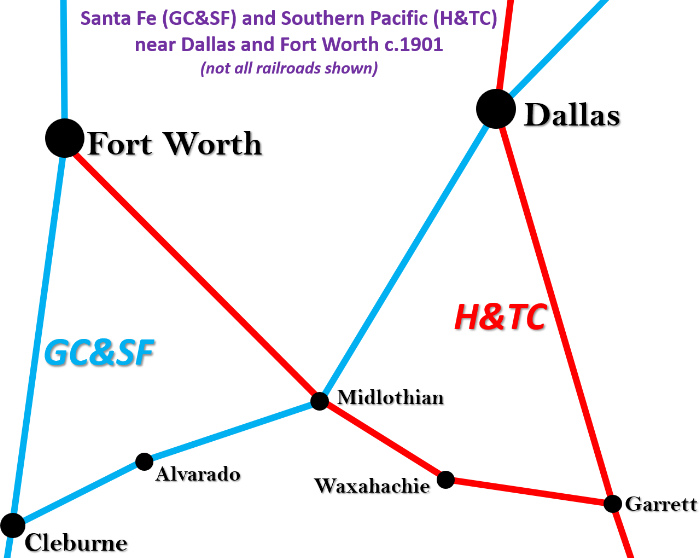
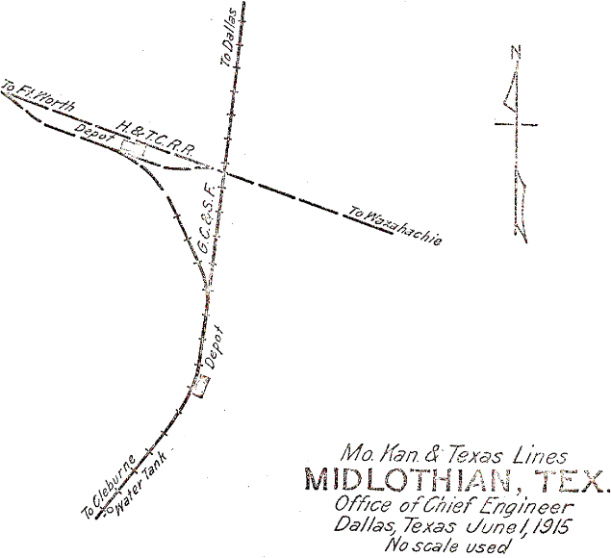
Above Left: The
end result for Midlothian was that it was well placed at the north Texas
crossroads of two of the largest rail systems in the U.S. It also had the Austin
Chalk Escarpment running north / south through town which led to its
becoming the center of cement quarrying and production in Texas. Midlothian eventually hosted three
of the ten largest cement manufacturers in the U.S., all served
by rail. Above Right: This
1915 track chart (courtesy, Ed Chambers) from the files of the Chief Engineer of
the Missouri, Kansas & Texas Railroad shows that both railroads had depots in
the vicinity of the crossing. The Santa Fe depot was near the center of town.
On November 19, 1913, the Railroad Commission of Texas (RCT) authorized an interlocker designated Tower 94 to commence operations controlling the GC&SF / H&TC crossing at Midlothian. It was a 23-function electrical plant housed in a two-story, manned tower located in the southeast quadrant of the crossing diamond. It continued to be reported as a 23-function electrical plant through the end of 1930 when RCT published its last list of active interlockers. RCT records show that the GC&SF was responsible for operating the tower, and photos show the tower to have been a GC&SF design, resembling others built and managed by the GC&SF (e.g. Tower 19, Tower 24.) However, the January, 1916 edition of Railway Review reported ... "The Houston & Texas Central Railway installed a new interlocking plant at Midlothian, Tex." It seems highly unlikely that this was a replacement for the plant that had been installed only two years earlier (and none of its details changed in RCT's annual list of active interlockers.) More likely, this was simply delayed reporting of an earlier press release by H&TC. Associating the plant installation with the H&TC does seem odd, although clearly the railroads worked closely on these kinds of projects. As the crossing had existed prior to 1901, RCT rules required the two railroads to split the capital expense to build the tower and install the interlocker. Operation and maintenance expenses were shared on the basis of the ratio of each railroad's interlocker functions compared to the total, but the precise split of interlocking functions between them at Midlothian is undetermined.
 Left:
This 1956 aerial image ((c)historicaerials.com) of the Midlothian crossing shows
the tower casting a shadow to the north across the SP tracks. A spur off the SP
tracks into the business in the west quadrant is barely visible, but it does not
appear to be the connecting track identified on the 1915 track chart.
Left:
This 1956 aerial image ((c)historicaerials.com) of the Midlothian crossing shows
the tower casting a shadow to the north across the SP tracks. A spur off the SP
tracks into the business in the west quadrant is barely visible, but it does not
appear to be the connecting track identified on the 1915 track chart.
Below: The Santa Fe depot
in Midlothian has been relocated and repurposed as a hair styling salon.
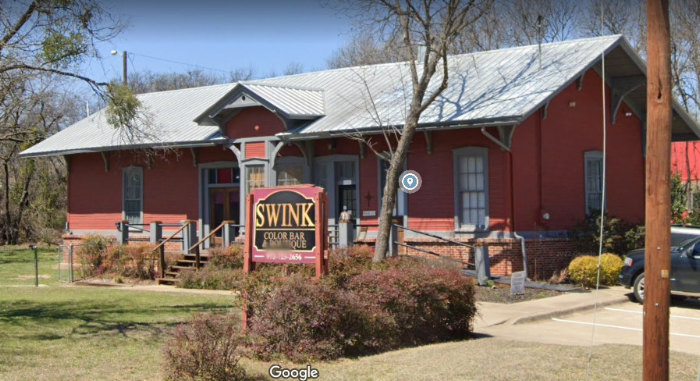
 |
Left: This excerpt
from a 1959 T&NO Employee Timetable shows that Tower 94 had been
automated by then. A 1949 Santa Fe Employee Timetable does
not show the interlocker as automated.
To house the automatic plant and related equipment, the tower remained standing after the
new interlocker was
installed and it survived at least to the early 1980s. The date of its final demise has not been determined. Right: T&NO depot at Midlothian, closed and boarded up, February 14, 1961 (Everett L. DeGolyer, Jr. photo) |
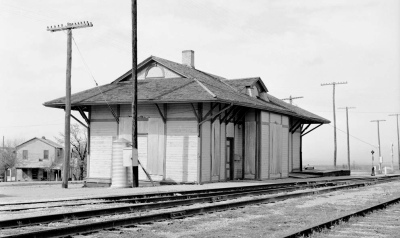 |
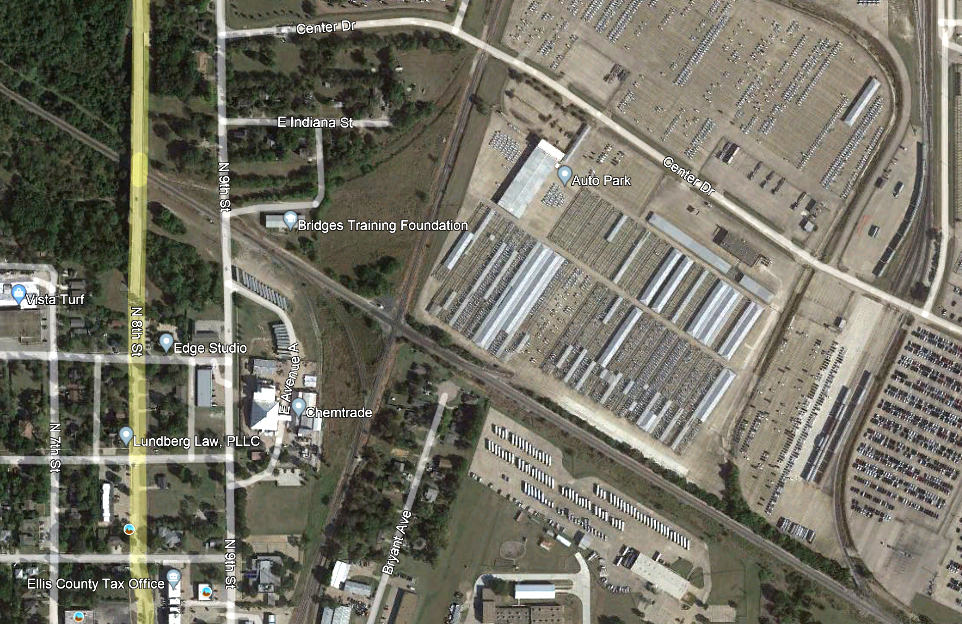
Above: This Google
Earth image from October, 2021 shows the Tower 94 crossing with two connecting
tracks in the west side quadrants. Visible in the northeast quadrant of the crossing is a small portion of
a massive rail park and automobile logistics center served by the railroads.
Below: This Google Street View from April, 2022 looks north toward the crossing
from Farm Road 1387 near downtown Midlothian.
